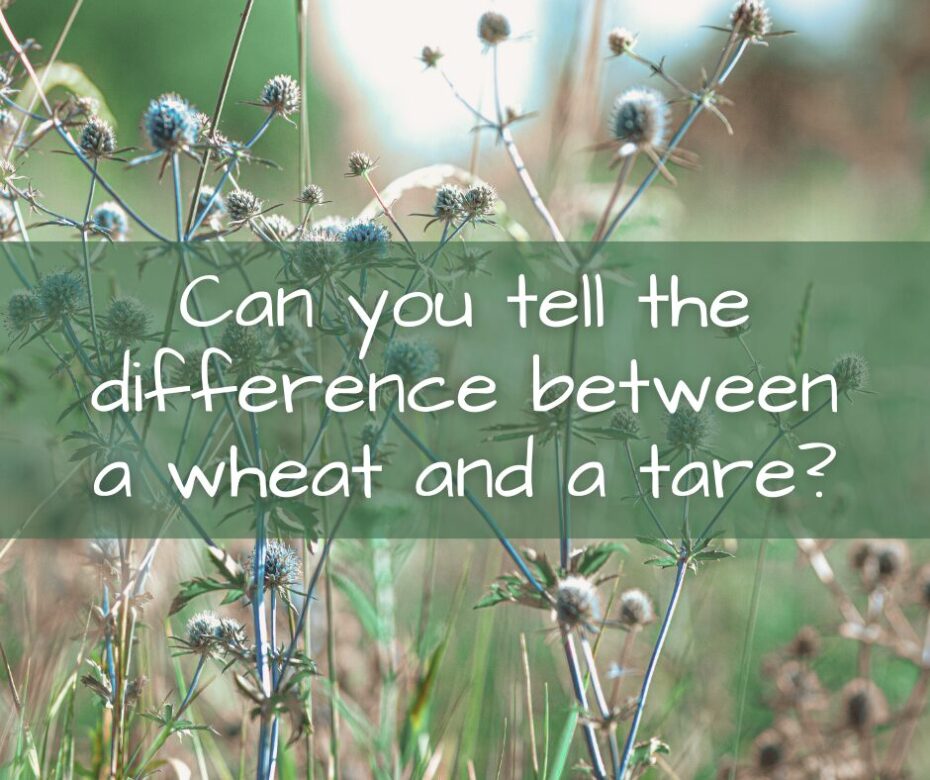In the Parable of the Wheat and the Tares, found in Matt 13:24-30, the Lord tells a story about a man who goes into a field and sows good seed. However, after he sows that seed, his enemy comes and sows bad seed in with the wheat. Because of this, the bad seed springs up as tares, or weeds, alongside the good crop. The man’s servants ask what they should do in response to this attack. The master tells them to wait for the time of harvest. They can then separate the wheat from the tares.
In verses 36-43, the Lord explains the parable to the disciples privately. The field symbolizes the world (v 38a), the good seed symbolizes the sons of the kingdom (v 38), and the tares symbolize the sons of the wicked one (v 38b). In other words, the wheat represents believers, while the tares represent unbelievers. The man’s enemy represents the devil, the enemy of God, the reapers represent angels (v 41, cf. 24:31), and the time of reaping is the end of the age.
You can check out this blog for a discussion on the phrase “sons of the Kingdom.” In addition, you can hear Bob Wilkin’s remarks regarding the phrase “the end of the age” here. However, in this blog I would like to address another element of the parable: The wheat and the tares look the same. I am not a farmer, but from what I have read, tares are practically indistinguishable from wheat. Furthermore, their roots and the wheat’s roots intertwine so that any attempt to remove them prematurely would result in damage to the good crop.
Haller remarks:
The point of the parable is that ‘the devil’ attempts to oppose the success of God’s kingdom by imitation, infiltration, and deceit (2 Cor 11:2-3, 13-15) (The Grace New Testament Commentary, page 39, emphasis added).
Reformed, Arminian and Free Grace commentators agree on the identity of the wheat and the tares. The wheat represents believers (= the sons of the Kingdom), while the tares represent unbelievers (= sons of the wicked one). In addition, there is general agreement that the two look the same. However, this poses a problem for Reformed and Arminian proponents.
Craig Keener makes this statement regarding the parable:
The parable may also reinforce images of conversion, perseverance, and apostasy in the parable of the sower (13:3-9, 18-23): especially in places where disciples can blend into the world (13:22), one cannot be sure who will prove to be God’s elect until the final judgment (A Commentary on the Gospel of Matthew, page 385, emphasis added).
Keener, an Arminian, states that the believer and the unbeliever can look the same. He supports this by referencing the third seed that falls upon the rocky ground in the Parable of the Sower (13:22). That a believer can be seduced by the riches and pleasures of the world and blend in with the world supports the Free Grace notion that believers can behave and even look like unbelievers.
However, Keener also asserts that a person’s nature will be observable in his works. In his discussion of Matthew 7, just a few chapters before the Parable of the Wheat and Tares, Keener remarks:
Jesus’ words about fruit thus refer to repentant works (7:21; 3:8, 10), recalling Jesus’ ethical teachings in 5:21–7:12. Jesus uses a word for bad fruit that often means “rotten,” though here the meaning is “worthless.” Many ancients recognized that, despite all pretense, an evil person’s nature was bound to emerge” (Pages 252-53, emphasis added).
There is a contradiction between Keener’s comments on Matthew 7 and the message of the Parable of the Wheat and the Tares. On the one hand, believers can be identified by their works, and on the other, unbelievers and believers can be indistinguishable from one another in this life.
This leads to the second problem with Keener’s position. If a person looks to his ever-changing works for assurance, then “one cannot be sure,” until the Lord returns, of his eternal salvation. Keener’s view offers no assurance of salvation. Of course, this contradicts the clear teaching of our Savior that the one who believes in Him for eternal life has that life as a present position (John 5:24; 6:40, 47) and is utterly assured of his eternal destiny (John 10:28-29; 1 John 5:13; 2 Tim 2:13).
Finally, the third problem with Keener’s interpretation of the parable is that it perpetuates an unfortunate misunderstanding regarding the fable of a single final judgment of all mankind. The Bible does not speak of such an event. By contrast, the Lord said that those who believe in Him “shall not come into judgment (John 5:24).” The Parable of the Wheat and the Tares likely refers to the gathering that will occur at the Lord’s return after the Tribulation, and therefore does not involve the church age saint.
In summary, Keener and others who deny assurance of salvation come to this parable and find themselves in confusing theological weeds.

